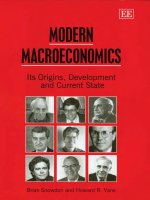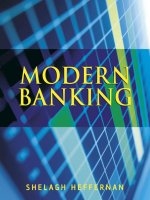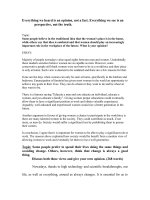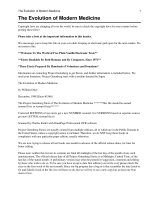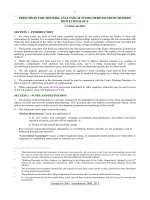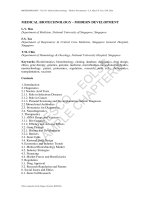Modern macroeconomics
Bạn đang xem bản rút gọn của tài liệu. Xem và tải ngay bản đầy đủ của tài liệu tại đây (3.09 MB, 826 trang )
Modern Macroeconomics
In loving memory of Brian’s parents, Joseph and Margaret Snowdon, and
Howard’s father, Philip M. Vane
Modern
Macroeconomics
Its Origins, Development and Current State
Brian Snowdon
Principal Lecturer in Economics in the Newcastle Business
School, Northumbria University, Newcastle upon Tyne, UK
Howard R. Vane
Professor of Economics in the School of Accounting, Finance
and Economics, Liverpool John Moores University, Liverpool,
UK
Edward Elgar
Cheltenham, UK • Northampton, MA, USA
© Brian Snowdon, Howard R. Vane 2005
All rights reserved. No part of this publication may be reproduced, stored in
a retrieval system or transmitted in any form or by any means, electronic,
mechanical or photocopying, recording, or otherwise without the prior
permission of the publisher.
Published by
Edward Elgar Publishing Limited
Glensanda House
Montpellier Parade
Cheltenham
Glos GL50 1UA
UK
Edward Elgar Publishing, Inc.
136 West Street
Suite 202
Northampton
Massachusetts 01060
USA
A catalogue record for this book
is available from the British Library
ISBN 1 84376 394 X (cased)
1 84542 208 2 (paperback)
Typeset by Manton Typesetters, Louth, Lincolnshire, UK.
Printed and bound in Great Britain by MPG Books Ltd, Bodmin, Cornwall.
v
Contents
List of figures x
List of tables xiii
Preface xiv
Acknowledgements xvii
1 Understanding modern macroeconomics 1
1.1 Macroeconomic issues and ideas 1
1.2 The role of economic theory and controversy 3
1.3 Objectives, instruments and the role of government 7
1.4 The Great Depression 9
1.5 Keynes and the birth of macroeconomics 13
1.6 The rise and fall of the Keynesian consensus 15
1.7 Theoretical schizophrenia and the neoclassical synthesis 21
1.8 Schools of thought in macroeconomics after Keynes 24
1.9 The new political macroeconomics 29
1.10 The renaissance of economic growth research 32
2Keynes v. the ‘old’ classical model 36
2.1 Introduction 36
2.2 Classical macroeconomics 37
2.3 Employment and output determination 38
2.4 Say’s Law 45
2.5 The quantity theory of money 50
2.6 Keynes’s General Theory 54
2.7 Interpreting the General Theory 57
2.8 Keynes’s main propositions 58
2.9 Keynes’s analysis of the labour market 65
2.10 Keynes’s rejection of Say’s Law 69
2.11 Keynes and the quantity theory of money 69
2.12 Three important interpretations of Keynes 70
2.13 The ‘new’ Keynes scholarship 75
2.14 Causes and consequences of the Great Depression 76
2.15 How to pay for the war 82
2.16 Keynes and international macroeconomics 83
2.17 Keynes’s legacy and the classical revival 85
Interview with Robert Skidelsky 91
3 The orthodox Keynesian school 101
3.1 Introduction 101
3.2 The orthodox Keynesian school 102
3.3 The IS–LM model for a closed economy 102
3.4 Underemployment equilibrium in the Keynesian model 114
3.5 The IS–LM model for an open economy 123
3.6 The Phillips curve and orthodox Keynesian economics 135
3.7 The central propositions of orthodox Keynesian economics 144
Interview with James Tobin 148
4 The orthodox monetarist school 163
4.1 Introduction 163
4.2 The quantity theory of money approach 165
4.3 The expectations-augmented Phillips curve analysis 174
4.4 The monetary approach to balance of payments theory and
exchange rate determination 187
4.5 The orthodox monetarist school and stabilization policy 192
Interview with Milton Friedman 198
5 The new classical school 219
5.1 Introduction 219
5.2 The influence of Robert E. Lucas Jr 220
5.3 The structure of new classical models 223
5.4 Equilibrium business cycle theory 236
5.5 The policy implications of the new classical approach 242
5.6 An assessment 267
Interview with Robert E. Lucas Jr 272
6 The real business cycle school 294
6.1 Introduction: the demise of new classical macroeconomics
mark I 294
6.2 The transition from monetary to real equilibrium business
cycle theory 295
6.3 Real business cycle theory in historical perspective 297
6.4 Cycles versus random walks 300
6.5 Supply-side shocks 303
6.6 Business cycles: main features and stylized facts 304
6.7 Real business cycle theory 307
6.8 The structure of a real business cycle model 309
vi Modern macroeconomics
Contents vii
6.9 Technology shocks 313
6.10 A real business cycle aggregate demand and supply model 315
6.11 Calibrating the model 320
6.12 Real business cycle theory and the neutrality of money 322
6.13 Measuring technology shocks: the Solow residual 325
6.14 Real business cycle theory and the stylized facts 326
6.15 The policy implications of real business cycle theory 330
6.16 Criticisms of real business cycle theory 332
6.17 Great Depressions: a real business cycle view 336
6.18 An assessment 338
Interview with Edward C. Prescott 344
7 The new Keynesian school 357
7.1 The fall and rise of Keynesian economics 357
7.2 A Keynesian resurgence 358
7.3 New Keynesian economics 361
7.4 Core propositions and features of new Keynesian economics 363
7.5 Nominal rigidities 366
7.6 Dornbusch’s overshooting model 376
7.7 Real rigidities 378
7.8 New Keynesian business cycle theory 396
7.9 Hysteresis and the NAIRU 401
7.10 New Keynesian economics and the stylized facts 408
7.11 Policy implications 409
7.12 Keynesian economics without the LM curve 423
7.13 Criticisms of new Keynesian economics 428
7.14 An assessment of new Keynesian economics 431
Interview with N. Gregory Mankiw 433
8 The Post Keynesian school 451
Paul Davidson
8.1 Introduction 451
8.2 The significance of the principle of effective demand 453
8.3 Taxonomy 454
8.4 Keynes’s taxonomic attack on Say’s Law 455
8.5 Can relative price changes induce D
2
to fill the gap? 457
8.6 Investment spending, liquidity, and the non-neutrality of
money axiom 459
8.7 What type of an economic system is ‘irrational’ enough to use
money contracts? 461
8.8 Information, decisions and uncertainty 463
8.9 Classifying decision-making environments 464
8.10 Keynesian uncertainty, money and explicit money contracts 468
8.11 Conclusions 472
9 The Austrian school 474
Roger W. Garrison
9.1 The Mengerian vision 474
9.2 The intertemporal structure of capital 475
9.3 Saving and economic growth 479
9.4 The saving–investment nexus 482
9.5 The market for loanable funds 489
9.6 Full employment and the production possibilities frontier 492
9.7 The capital-based macroeconomic framework 496
9.8 Saving-induced capital restructuring 498
9.9 Keynes’s paradox of thrift revisited 501
9.10 The Austrian theory of the business cycle 503
9.11 A Keynesian downturn in the Austrian framework 509
9.12 Inflation and deflation in the Austrian theory 513
9.13 Policy and reform 515
10 The new political macroeconomics 517
10.1 Introduction: political distortions and macroeconomic
performance 517
10.2 Political influences on policy choice 518
10.3 The role of government 521
10.4 Politicians and stabilization policy 523
10.5 Alternative approaches to the ‘political business cycle’: an
overview 525
10.6 The Nordhaus opportunistic model 526
10.7 The Hibbs partisan model 532
10.8 The decline and renaissance of opportunistic and partisan
models 535
10.9 Rational political business cycles 537
10.10 Rational partisan theory 538
10.11 Opportunistic and partisan behaviour: a synthesis 545
10.12 Politics, time inconsistency, credibility and reputation 546
10.13 Policy implications of politico-economic models: an
independent central bank? 549
10.14 The political economy of debt and deficits 554
10.15 Political and economic instability: are they related? 555
10.16 The political economy of economic growth 556
10.17 Political barriers to economic growth 562
10.18 The size of nations 564
viii Modern macroeconomics
Contents ix
10.19 Conclusion 565
Interview with Alberto Alesina 567
11 The renaissance of economic growth research 579
11.1 Introduction 579
11.2 The ‘Great Divergence’ 580
11.3 In praise of economic history 584
11.4 Back to the long run 585
11.5 Why is economic growth so important? 589
11.6 Modern economic growth in historical perspective 593
11.7 The stylized facts of growth 595
11.8 Proximate v. fundamental sources of growth 596
11.9 The Harrod–Domar model 598
11.10 The Solow neoclassical growth model 602
11.11 Accounting for the sources of economic growth 612
11.12 The convergence debate 614
11.13 Beyond the Solow model 622
11.14 Endogenous growth: constant returns to capital accumulation 625
11.15 Endogenous growth: the economics of ideas 627
11.16 An augmented Solow model: a neoclassical revival? 632
11.17 Focusing on the fundamental causes of growth 633
11.18 Institutions and economic growth 635
11.19 Trade and economic growth 647
11.20 Geography and growth 652
11.21 Growth in history: in search of a unified theory 654
11.22 The ideal conditions for growth and development:
rediscovering old truths 657
Interview with Robert M. Solow 660
Interview with Paul M. Romer 673
12 Conclusions and reflections 695
12.1 Introduction 695
12.2 Twentieth-century developments in macroeconomics:
evolution or revolution? 696
12.3 Is there a consensus on key macroeconomic issues? 703
Bibliography 708
Author index 791
Subject index 803
x
Figures
1.1 Unemployment in the US and UK economies over the course
of the twentieth century 2
1.2 Inflation in the US and UK economies over the course of the
twentieth century 3
2.1 The aggregate production function (a) and the marginal
product of labour (b) 40
2.2 Output and employment determination in the classical model 43
2.3 The classical interest rate mechanism and Say’s Law 48
2.4 The determination of the price level in the classical model 53
2.5 The determination of output and employment 64
2.6 Keynes and involuntary unemployment 67
2.7 Aggregate demand failure in the US economy, 1929–33 78
3.1 Demand for speculative balances 105
3.2 The generalized IS–LM model 105
3.3 Expansionary fiscal policy 107
3.4 Expansionary monetary policy 108
3.5 The government budget constraint and bond-financed fiscal
expansion 111
3.6 The general case with the Keynes effect 115
3.7 The liquidity trap case 117
3.8 The interest-inelastic investment case 119
3.9 The Mundell–Fleming/Keynesian model 127
3.10 Fiscal expansion under imperfect capital mobility 128
3.11 Monetary expansion under imperfect capital mobility 129
3.12 Fiscal expansion under (a) and (b) imperfect and (c) perfect
capital mobility 131
3.13 Monetary expansion under (a) imperfect and (b) perfect
capital mobility 134
3.14 The Phillips curve 136
3.15 The relationship between wage change and excess demand for
labour 138
3.16 The relationship between excess demand for labour and
unemployment 139
3.17 The relationship between excess demand for labour, vacancy
and unemployment rates 141
Figures xi
3.18 The link between the Keynesian model and wage and price
inflation 143
4.1 The evolution of orthodox monetarism 164
4.2 The classical case 172
4.3 The Keynesian case 172
4.4 The expectations-augmented Phillips curve 177
4.5 The trade-off between inflation and unemployment 179
4.6 The output–employment costs of reducing inflation 183
5.1 The structure of new classical models 224
5.2 The welfare implications of equilibrium in a competitive
market 231
5.3 The effects of anticipated and unanticipated changes in the
money supply on the level of output and the price level 243
5.4 Consistent and optimal equilibrium 253
5.5 Game played between the monetary authorities and wage
negotiators 255
5.6 The relationship between average inflation and central bank
independence 261
5.7 The evolution of new classical macroeconomics 269
6.1 The path of output in the ‘trend-reverting’ case 302
6.2 The path of output where shocks have a permanent influence 302
6.3 Output and employment fluctuations due to a technology
shock 314
6.4 The IS–LM model with flexible prices 315
6.5 The real business cycle aggregate demand and supply model 316
6.6 The impact of a technology shock 318
6.7 The impact of a government expenditure shock 319
6.8 The impact of temporary and permanent technology shocks in
the real business cycle model 320
6.9 The annual growth rates of technology and output in the USA,
1955–85 327
6.10 Supply shocks and the price level 329
7.1 Nominal wage contracts, rational expectations and monetary
policy 368
7.2 Price adjustment under monopolistic competition 373
7.3 Menu costs v. price adjustment 374
7.4 Near rationality 375
7.5 The efficiency wage and the Solow condition 386
7.6 Involuntary unemployment in the efficiency wage model 387
7.7 The shirking model 391
7.8 The impact of an aggregate demand shock in the new
Keynesian model 397
7.9 The risk-based aggregate supply curve 400
7.10 Standardized unemployment rates for North America (USA
and Canada) and OECD Europe, 1972–98 402
7.11 The ‘natural rate’ view of the relationship between actual
unemployment and equilibrium unemployment 404
7.12 The hysteresis view of a ‘time-varying’ NAIRU 406
7.13 Bank of England inflation report fan chart for February 2004:
forecast of CPI inflation at constant nominal interest rates of
4.0 per cent 417
7.14 UK inflation and inflation expectations, October 1991–
October 2003 418
7.15 Derivation of the AD curve 425
7.16 Adjusting to long-run equilibrium in the AD–IA model 427
9.1 The intertemporal structure of production 476
9.2 A possible temporal pattern of consumable output 480
9.3 Intertemporal capital restructuring 481
9.4 Time discount and derived demand 488
9.5 The loanable funds market 490
9.6 The production possibilities frontier 495
9.7 A capital-based macroeconomic framework 496
9.8 Saving-induced economic growth 498
9.9 A saving-induced recession 502
9.10 A policy-induced boom and bust 505
9.11 An investment-led collapse into recession 511
10.1 Influences on policy choice 520
10.2 A politico-economic model 524
10.3 The Nordhaus political business cycle model 529
10.4 The long-run solution in the Nordhaus model 530
10.5 The Hibbs partisan model 533
10.6 How inequality may adversely affect growth 561
11.1 The impact on per capita income of differential growth rates 591
11.2 The great divergence 591
11.3 The neoclassical aggregate production function 605
11.4 The Solow growth model 608
11.5 Technological progress 610
11.6 Transition dynamics 618
11.7 Conditional convergence 619
11.8 Proximate and fundamental sources of growth 634
xii Modern macroeconomics
xiii
Tables
1.1 The Great Depression 12
1.2 Growth of per capita GDP, world and major regions, 1820–
1998 18
1.3 Growth rates (GDP), 1820–1998 18
1.4 Unemployment rates, 1964–2002 19
1.5 Inflation rates, 1964–2002 20
2.1 US GDP, prices and unemployment: 1929–33 78
2.2 Keynes and the international economic system, 1944 85
2.3 Most-cited macroeconomists: 1920–30 86
2.4 Most-cited macroeconomists: 1931–5 86
2.5 Most-cited macroeconomists: 1936–9 87
2.6 Most-cited macroeconomists: 1940–44 87
5.1 Citation counts: 1966–97 221
5.2 Central bank independence and economic performance 260
6.1 The ‘stylized facts’ of the business cycle 306
7.1 NAIRU estimates for the G7 countries and the euro area 402
7.2 Evidence on reasons for price stickiness 428
10.1 Politico-economic models of aggregate fluctuations 526
10.2 Partisan influence on macroeconomic outcomes, USA, 1948–
2001 534
10.3 Rates of growth of GDP in real terms 543
10.4 Alternative politico-economic models 547
10.5 Selected indicators of governance: 20 sub-Saharan African
countries 559
11.1 Level and rate of growth of GDP per capita: world and major
regions, 0–1998
AD
581
11.2 Three indicators of living standards: 40 countries 583
11.3 The cumulative impact of differential growth rates 590
11.4 A tale of two Koreas 639
11.5 Growth rates of per capita GDP (%): the two Koreas 640
12.1 Some areas of agreement and disagreement in macroeconomics 702
xiv
Preface
Over the last ten years we have collaborated in co-writing and/or editing five
books on macroeconomics. The first of this series of books, A Modern Guide
to Macroeconomics: An Introduction to Competing Schools of Thought, was
published by Edward Elgar in 1994, while our most recent joint venture, An
Encyclopedia of Macroeconomics, was published by Edward Elgar in 2002.
During the course of co-writing and editing the Encyclopedia of Macroeco-
nomics a number of eminent economists, who contributed to the project,
asked if we had any plans to write a second edition of the Modern Guide to
Macroeconomics, a book which has received widespread critical acclaim and
been translated into French (Ediscience, 1997), Chinese (Commercial Press,
1998), Italian (Etas Libri, 1998), and Polish (Polish Scientific Publishers,
1998). Initially we intended to produce a second edition of the Modern Guide
to Macroeconomics involving amendments to each chapter, as well as updat-
ing the data and references. However, as the project unfolded we decided that
the Modern Guide to Macroeconomics required an extensive rewrite, not only
involving major amendments to each chapter, but also requiring the addition
of two new chapters surveying the burgeoning literature on the ‘new political
macroeconomics’ and the ‘new growth’ literature. As a result of these exten-
sive changes we decided that the current book was sufficiently different to
warrant a new title, which reflects its theme and contents. In writing Modern
Macroeconomics: Its Origins, Development and Current State we have also
been kindly aided by two eminent scholars in their respective fields, Profes-
sor Paul Davidson who contributed Chapter 8 on the Post Keynesian school
and Professor Roger Garrison who contributed Chapter 9 on the Austrian
school.
The main aim of our new book, as reflected in its title, is to consider the
origins, development and current state of modern macroeconomics in a manner
appropriate for intermediate undergraduates taking courses in macroeconom-
ics. As such we have assumed that such students will already have a firm grasp
of basic economic principles and be familiar with introductory macroeconomic
theories and models as developed, for example, in textbooks such as those by
Abel and Bernanke (2001), Blanchard (2003), or Mankiw (2003). This book
should, however, also prove useful to students taking other undergraduate
economics courses, most notably in the history of economic thought, as well as
economic history. For the benefit of intermediate undergraduates we have
marked with an asterisk those references in the bibliography that are particu-
larly recommended for further reading. In providing extensive referencing the
book should also prove to be a useful introductory guide to the research
literature for postgraduate students in their preliminary year of study.
While the book is written so as to allow students on a range of degree
courses to read individual chapters in isolation, according to their interests
and needs, in line with the Modern Guide to Macroeconomics the book
follows a structured direction tracing the origins and development of modern
macroeconomics in historical perspective. In a book of this nature it is obvi-
ously impossible to cover every area. We have therefore aimed to highlight
what we consider to have been the major issues that emerged following the
birth of macroeconomics in the 1930s.
Following the introductory chapter on understanding macroeconomics,
Chapter 2 considers the debate between Keynes and the old classical model
before tracing the development of the orthodox Keynesian school (Chapter
3), the orthodox monetarist school (Chapter 4), the new classical school
(Chapter 5), the real business cycle school (Chapter 6), the new Keynesian
school (Chapter 7), the Post Keynesian school (Chapter 8) and the Austrian
school (Chapter 9). Readers familiar with a Modern Guide to Macroeconom-
ics will recognize our chosen approach, namely to discuss the central tenets
underlying, and the policy implications of, these main competing schools of
thought in macroeconomics as they evolved in historical perspective. In
doing so we have taken the opportunity to include in Chapters 2–7 more
recent references and, more importantly, to assess the impact these schools
have had on the current state of macroeconomics. We have also introduced
much new material compared to the equivalently titled chapters in a Modern
Guide to Macroeconomics. To give two examples: in Chapter 2, section 2.14,
we have introduced a discussion of the causes and consequences of the Great
Depression, while in Chapter 3, section 3.5, we discuss the effectiveness of
fiscal and monetary policy for stabilization purposes when the Keynesian IS–
LM model is extended to an open economy. In this book the Post Keynesian
and Austrian schools command individual chapters (each written by leading
scholars in the area), rather than the single chapter approach used in the
Modern Guide to Macroeconomics. Furthermore, to reflect important devel-
opments that have taken place in macroeconomics over the final decades of
the twentieth century we have introduced two entirely new chapters. In Chap-
ter 10 we consider what has come to be known as the ‘new political
macroeconomics’, while in Chapter 11 we discuss the renaissance of research
into the area of ‘economic growth’. It is hoped that these changes will be
welcomed by reviewers and readers alike.
In line with the Modern Guide to Macroeconomics, to help bring the
subject matter alive and capture the imagination of the reader, we have
Preface xv
included at the end of certain chapters interviews with world-renowned scholars
who are experts in their field of study. We are extremely grateful to (listed in
the order in which the interviews appear in the book): Robert Skidelsky (a
leading authority on Keynes and the interwar period); the late James Tobin
(the 1981 Nobel Memorial Laureate, who was one of America’s most promi-
nent and distinguished Keynesian economists); Milton Friedman (the 1976
Nobel Memorial Laureate, who is widely recognized as the founding father
of monetarism); Robert E. Lucas Jr (the 1995 Nobel Memorial Laureate, who
is widely acknowledged as the leading figure in the development of new
classical macroeconomics); Edward Prescott (widely acknowledged as a lead-
ing advocate of the real business cycle approach to economic fluctuations);
Greg Mankiw (a leading exponent of the new Keynesian school of macroeco-
nomics); Alberto Alesina (a leading contributor to the literature on the new
political macroeconomics); and Robert Solow (the 1987 Nobel Memorial
Laureate) and Paul Romer, who have made very influential contributions to
the field of economic growth. Their illuminating and contrasting answers
demonstrate that modern macroeconomics is both an exciting and controver-
sial subject. As an aside the reader may wonder why we have not included
interviews at the end of Chapter 8 on the Post Keynesian school and Chapter
9 on the Austrian school. The reason for this is that these two chapters have
been written by Paul Davidson, a leading world authority on Post Keynesian
economics, and Roger Garrison, a leading world authority on Austrian eco-
nomics – the two people we would have chosen to interview if they hadn’t
kindly agreed to write Chapters 8 and 9 respectively.
Thus, for the potential reviewer or prospective buyer it should be clear that
this book is far more than a second edition of the Modern Guide to Macr-
oeconomics. It is a new book which we hope successfully conveys the
importance of the issues under discussion. As Keynes recognized, the ideas
of economists are more powerful than is commonly understood. In this book
we have attempted to show why this is the case by tracing the development
and interaction of key events and ideas as they occurred during the twentieth
century and into the new millennium.
Brian Snowdon
Howard R. Vane
xvi Modern macroeconomics
xvii
Acknowledgements
The authors would like to thank the following who have kindly given their
permission to reproduce previously published material, namely:
The NIESR to reproduce Figures 1.1 and 1.2 from the article by A. Britton,
‘Macroeconomics and History’, in the National Institute Economic Review,
January 2002.
The Ohio State University Press to reproduce Figure 5.6 and Table 5.2
from the article by A. Alesina and L.H. Summers, ‘Central Bank Independ-
ence and Macroeconomic Performance: Some Comparative Evidence’, Journal
of Money, Credit and Banking, May 1993.
The OECD to reproduce Tables 1.2 and 11.1 from the book by A. Maddison,
The World Economy: A Millennial Perspective, copyright 2001, OECD.
Palgrave Macmillan to reproduce Tables 2.3–2.6 from the book by P.
Deutscher, R.G. Hawtrey and the Development of Macroeconomics, 1990,
Macmillan.
Pearson Education, Inc. publishing as Pearson Addison Wesley to reproduce
Table 6.1 from the book by A.B. Abel and B.S. Bernanke, Macroeconomics, 4
th
edn., p. 288, copyright 2001, Pearson Education.
The International Honor Society in Economics to reproduce the interview
with Greg Mankiw which appears as part of a fuller article by the authors,
‘New Keynesian Economics Today: The Empire Strikes Back’, in The Ameri-
can Economist, Spring 1995.
MCB University Press to reproduce the interview with Milton Friedman
which appears as part of a fuller article by the authors, ‘Modern Macroeco-
nomics and Its Evolution from a Monetarist Perspective: An Interview with
Professor Milton Friedman’, in the Journal of Economic Studies, 1997.
Routledge to reproduce the interview with Robert E. Lucas Jr which ap-
pears as part of a fuller article by the authors, ‘Transforming Macroeconomics:
An Interview with Robert E. Lucas Jr.’, in the Journal of Economic Method-
ology, June 1998.
The International Honor Society on Economics to reproduce the interview
with Alberto Alesina which appears as part of a fuller article by the authors,
‘The New Political Macroeconomics’, in The American Economist, Spring
1999.
NTC Economic and Financial Publishing, Washington, DC, USA and
Henley-on Thames, UK to reproduce the interview with James Tobin which
appears as part of a fuller article by the authors, ‘James Tobin, 1918–2002:
An “Unreconstructed Old Keynesian” Who Wouldn’t Quit’, in World Eco-
nomics, July–September 2002.
The authors also wish to thank Professor Paul Romer for permission to use
their interview with him, the copyright on which is held by Professor Romer.
xviii Modern macroeconomics
1
1. Understanding modern
macroeconomics
Economic knowledge is historically determined … what we know today about the
economic system is not something we discovered this morning but is the sum of
all our insights, discoveries and false starts in the past. Without Pigou there would
be no Keynes; without Keynes no Friedman; without Friedman no Lucas; without
Lucas no … (Blaug, 1991a, pp. x–xi)
1.1 Macroeconomics Issues and Ideas
Macroeconomics is concerned with the structure, performance and behaviour
of the economy as a whole. The prime concern of macroeconomists is to
analyse and attempt to understand the underlying determinants of the main
aggregate trends in the economy with respect to the total output of goods and
services (GDP), unemployment, inflation and international transactions. In
particular, macroeconomic analysis seeks to explain the cause and impact of
short-run fluctuations in GDP (the business cycle), and the major determi-
nants of the long-run path of GDP (economic growth). Obviously the subject
matter of macroeconomics is of crucial importance because in one way or
another macroeconomic events have an important influence on the lives and
welfare of all of us. It is difficult to overstate just how important satisfactory
macroeconomic performance is for the well-being of the citizens of any
country. An economy that has successful macroeconomic management should
experience low unemployment and inflation, and steady and sustained eco-
nomic growth. In contrast, in a country where there is macroeconomic
mismanagement, we will observe an adverse impact on the living standards
and employment opportunities of the citizens of that country. In extreme
circumstances the consequences of macroeconomic instability have been dev-
astating. For example, the catastrophic political and economic consequences
of failing to maintain macroeconomic stability among the major industrial
nations during the period 1918–33 ignited a chain of events that contributed
to the outbreak of the Second World War, with disastrous consequences for
both humanity and the world economy.
Because macroeconomic performance and policies are closely connected,
the major macroeconomic issues are also the subject of constant media atten-
tion and inevitably play a central role in political debate. The influence of the
2 Modern macroeconomics
economic performance of the economy on political events is particularly
important and pertinent in liberal democracies during election campaigns.
Research has confirmed that in the post-war period the outcome of elections
has in many cases been affected by the performance of the economy as
measured by three main macroeconomic indicators – inflation, unemploy-
ment and economic growth. While there are obviously many non-economic
factors that influence the ‘happiness’ of voters, it is certainly the case that
economic variables such as employment and income growth are an important
explanatory factor in voting behaviour. Furthermore, ideological conflict of-
ten revolves around important macroeconomic issues (see, for example, Frey
and Schneider, 1988; Alesina and Roubini with Cohen, 1997; Drazen, 2000a).
To get some idea of how two major economies have performed with respect
to unemployment and inflation consider Figures 1.1 and Figure 1.2. Here we
can clearly see that the pathologies of high unemployment and inflation occa-
sionally take on proportions that are well above the norm. Figure 1.1 traces the
path of unemployment in the US and UK economies for the twentieth century.
The impact of the Great Depression (1929–33) on unemployment is dramati-
cally illustrated for both countries although the increase in unemployment in
the USA was much more dramatic than in the UK, where unemployment was
already high before 1929 (see section 1.4 below and Chapter 2).
Source: Britton (2002).
Figure 1.1 Unemployment in the US and UK economies over the course of
the twentieth century
25
20
15
10
5
0
US unemployment UK unemployment
1900
1910 1920 1930 1940 1950 1960 1970 1980 1990
Understanding modern macroeconomics 3
Source: Britton (2002).
Figure 1.2 Inflation in the US and UK economies over the course of the
twentieth century
25
20
15
10
5
0
–5
–10
–15
–20
US inflation UK inflation
1900
1910 1920 1930 1940 1950 1960 1970 1980 1990
Figure 1.2 shows how inflation has varied in the US and the UK economies
throughout the twentieth century. Notable features here include: the dramatic
increase in inflation associated with the two world wars (1914–18, 1939–45)
and the Korean War (1950–53); the deflations of the early 1920s and 1930s;
and the ‘Great Inflation’ of the 1970s (Taylor, 1992a). As DeLong (1997)
notes, ‘the 1970s are America’s only peacetime outburst of inflation’.
Several questions confront economists with respect to these exceptional
episodes: were they due to specific large shocks, the failure of adjustment
mechanisms, the result of policy errors, or some combination of all three?
Finding answers to these questions is important because the contemporary
conduct of stabilization policy must reflect the lessons of history and the
theoretical and empirical research findings of economists.
1.2 The Role of Economic Theory and Controversy
An understanding by government policy makers of the factors which determine
the long-run growth of an economy and the short-run fluctuations that consti-
tute the business cycle is essential in order to design and implement economic
policies which have the potential vastly to improve economic welfare. The
primary aim of macroeconomic research is to develop as comprehensive an
4 Modern macroeconomics
understanding as possible of the way the economy functions and how it is
likely to react to specific policies and the wide variety of demand and supply
shocks which can cause instability. Macroeconomic theory, consisting of a set
of views about the way the economy operates, organized within a logical
framework (or theory), forms the basis upon which economic policy is de-
signed and implemented. Theories, by definition, are simplifications of reality.
This must be so given the complexity of the real world. The intellectual prob-
lem for economists is how to capture, in the form of specific models, the
complicated interactive behaviour of millions of individuals engaged in eco-
nomic activity. Huntington (1996) has succinctly outlined the general case for
explicit modelling as an essential aid to thought:
Simplified paradigms or maps are indispensable for human thought. On the one
hand, we may explicitly formulate theories or models and consciously use them to
guide behaviour. Alternatively, we may deny the need for such guides and assume
that we will act only in terms of specific ‘objective’ facts, dealing with each case
‘on its own merits’. If we assume this, however, we delude ourselves. For in the
back of our minds are hidden assumptions, biases, and prejudices that determine
how we perceive reality, what facts we look at, and how we judge their importance
and merits.
Accordingly, explicit or implicit models are necessary to make sense of a very
complex world. By definition economic theories and specific models act as the
laboratories we otherwise lack in the social sciences. They help economists
decide what are the important factors that need to be analysed when they run
thought experiments about the causes and consequences of various economic
phenomena. A successful theory will enable economists to make better predic-
tions about the consequences of alternative courses of action thereby indicating
the policy regime most likely to achieve society’s chosen objectives.
The design of coherent economic policies aimed at achieving an accept-
able rate of economic growth and reduced aggregate instability depends then
on the availability of internally consistent theoretical models of the economy
which can explain satisfactorily the behaviour of the main macro variables
and are not rejected by the available empirical evidence. Such models pro-
vide an organizing framework for reviewing the development and improvement
of institutions and policies capable of generating reasonable macroeconomic
stability and growth. However, throughout the twentieth century, economists
have often differed, sometimes substantially, over what is to be regarded as
the ‘correct’ model of the economy. As a result, prolonged disagreements and
controversies have frequently characterized the history of macroeconomic
thought (Woodford, 2000).
The knowledge that macroeconomists have today about the way that econo-
mies function is the result of a prolonged research effort often involving
Understanding modern macroeconomics 5
intense controversy and an ever-increasing data bank of experience. As
Blanchard (1997a) points out:
Macroeconomics is not an exact science but an applied one where ideas, theories,
and models are constantly evaluated against the facts, and often modified or
rejected … Macroeconomics is thus the result of a sustained process of construc-
tion, of an interaction between ideas and events. What macroeconomists believe
today is the result of an evolutionary process in which they have eliminated those
ideas that failed and kept those that appear to explain reality well.
Taking a long-term perspective, our current understanding of macroeconom-
ics, at the beginning of the twenty-first century, is nothing more than yet
another chapter in the history of economic thought. However, it is important
to recognize from the outset that the evolution of economists’ thinking on
macroeconomics has been far from smooth. So much so that many econo-
mists are not averse to making frequent use of terminology such as ‘revolution’
and ‘counter-revolution’ when discussing the history of macroeconomics.
The dramatic decline of the Keynesian conventional wisdom in the early
1970s resulted from both the empirical failings of ‘old Keynesianism’ and the
increasing success of critiques (‘counter-revolutions’) mounted by monetarist
and new classical economists (Johnson, 1971; Tobin, 1981, 1996; Blaug,
1997; Snowdon and Vane, 1996, 1997a, 1997b).
In our view, any adequate account of the current state of macroeconom-
ics needs to explore the rise and fall of the old ideas and the state of the new
within a comparative and historical context (see Britton, 2002). This book
examines, compares and evaluates the evolution of the major rival stories
comprising contemporary macroeconomic thought. We would maintain that
the coexistence of alternative explanations and views is a sign of strength
rather than weakness, since it permits mutual gains from intellectual trade
and thereby improved understanding. It was John Stuart Mill who recog-
nized, almost one hundred and fifty years ago, that all parties gain from the
comparative interplay of ideas. Alternative ideas not only help prevent
complacency, where ‘teachers and learners go to sleep at their post as soon
as there is no enemy in the field’ (Mill, 1982, p. 105), but they also provide
a vehicle for improved understanding whereby the effort to comprehend
alternative views forces economists to re-evaluate their own views. Contro-
versy and dialogue have been, and will continue to be, a major engine for
the accumulation of new knowledge and progress in macroeconomics. We
would therefore endorse Mill’s plea for continued dialogue (in this case
within macroeconomics) between the alternative frameworks and suggest
that all economists have something to learn from each other. The macro-
economic problems that economists address and endeavour to solve are
often shared.
6 Modern macroeconomics
That there is a wide variety of schools of thought in economics in general,
and macroeconomics in particular, should not surprise us given the intrinsic
difficulty and importance of the issues under investigation. While there are
‘strong incentives in academia to differentiate products’ (Blanchard and Fischer,
1989), there is no doubt that much of the controversy in macroeconomics
runs deep. Of course, it is true that economists disagree on many issues, but
they seem to do so more frequently, vociferously, and at greater length, in
macroeconomics. In his discussion of why there is much controversy in
macroeconomics Mayer (1994) identifies seven sources, namely, limited knowl-
edge about how the economy works, the ever-widening range of issues that
economists investigate, the need to take into account wider influences, such
as political factors, and differences in the ‘metaphysical cores, value judge-
ments, social empathies and methodologies’ of various economists. Knut
Wicksell’s (1958, pp. 51–2) contention that within economics ‘the state of
war seems to persist and remain permanent’ seems most appropriate for
contemporary macroeconomics. To a large extent this reflects the importance
of the issues which macroeconomists deal with, but it also supports the
findings of previous surveys of economists which revealed a tendency for
consensus to be stronger on microeconomic compared to macroeconomic
propositions (see, for example, Alston et al., 1992).
It is certainly true that in specific periods during the twentieth century the
contemporary state of macroeconomic theory had the appearance of a battle-
field, with regiments of economists grouped under different banners. However,
it is our view that economists should always resist the temptation to embrace,
in an unquestioning way, a one-sided or restrictive consensus ‘because the
right answers are unlikely to come from any pure economic dogma’ (Deane,
1983). In addition, the very nature of scientific research dictates that disa-
greements and debate are most vocal at the frontier, as they should be, and, as
Robert E. Lucas Jr argues (see interview at the end of Chapter 5), the respon-
sibility of professional economists is ‘to create new knowledge by pushing
research into new, and hence necessarily controversial, territory. Consensus
can be reached on specific issues, but consensus for a research area as a
whole is equivalent to stagnation, irrelevance and death.’ Furthermore, as
Milton Friedman observes (see interview at the end of Chapter 4), ‘science in
general advances primarily by unsuccessful experiments that clear the ground’.
Macroeconomics has witnessed considerable progress since its birth in the
1930s. More specifically, any Rip Van Winkle economist who had fallen
asleep in 1965, when the ‘old Keynesian’ paradigm was at its peak, would
surely be impressed on waking up at the beginning of the twenty-first century
and surveying the enormous changes that have taken place in the macroeco-
nomics literature.
